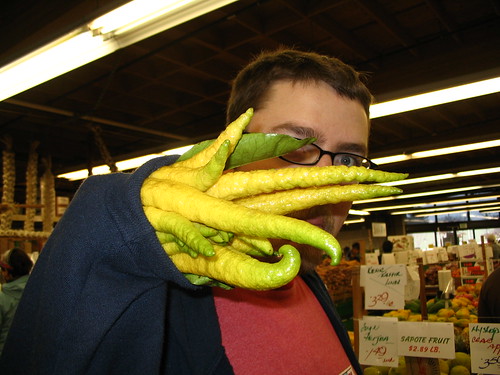The Wonderful World of Color
 That mass of colorful dots you see represents the bane of Little Miss Sunshine's Older Brother's existence. It's a part of the Ishihara color blindness test. What do you see? If you see the number (45, by the way), you're probably not color blind. If you don't see the number, you're probably red/green color blind, like me.*
That mass of colorful dots you see represents the bane of Little Miss Sunshine's Older Brother's existence. It's a part of the Ishihara color blindness test. What do you see? If you see the number (45, by the way), you're probably not color blind. If you don't see the number, you're probably red/green color blind, like me.*
Every now and then for some odd reason, the subject of my vision will come up in a social setting. Maybe a friend has tried on my spectacles, idly saying, "Just how blind are you, anyway?" and quickly pulled them back off, fighting off that cross-eyed headachey feeling wearing somebody else's specs always induces. Maybe it's because I've made yet another mistake in identifying an object's color - it happens pretty frequently. Anyway, in cases like these, I frequently lament my genetic curse. "I got my mother's eyes, but I got my father's vision," I say. My eyes are blue, like hers. I'm nearsighted, just like him. And I'm color blind, just like him.
Color blindness is one of those things about which people have a persistent misconception. When I say I'm color blind, a lot of people assume that it means that I'm unable to perceive color, that I see the whole world like a black-and-white movie. But I do see nearly an entire spectrum of color. Like most people who are color blind, I have difficulty with hue shifts in shorter wavelengths - the red/yellow/green end of the spectrum. The right combination of red and green can blend seamlessly with one another in my eyes. When they hit my cones, greens can quite easily turn themselves into blues. In low light, any subtle variation in color is essentially completely lost on me.
My mother once gave my father a lamp for Christmas. He was a little puzzled by it. "That's for a specific purpose," my mother said. "I want you to put that on top of your dresser, so you can tell which color socks you're pulling out of the drawer in the morning." That's why I have only three colors of socks - white, black, and brown that's light enough to clearly be brown to my eyes, even in low light.
Here's a typical scenario - let's imagine we've forgotten where we parked, and I just spotted our car...
Me: "There it is, between those two blue cars."
Em: "Where?"
Me: "Right there! Between the blue ones!"
Em: "Um, those cars are both green."
Me: "Oh."
I used to argue, but I've accepted that my eyes just don't perceive color in the usual way. It can be frustrating - especially as, you know, an artist - but I think it makes me pay more attention to color than a lot of people do. I know a lot more about how and why I respond to certain color schemes than I would otherwise. I know that subtle, muted palettes are wasted on me, and I'll be likely to go nuts for high-intensity, prismatic colors.
But trying to tell if something is really black or just navy blue drives me insane.
* The computer monitor isn't the ideal way to see this, as changes in viewing angle, brightness and other factors can alter the way the colors are perceived.


